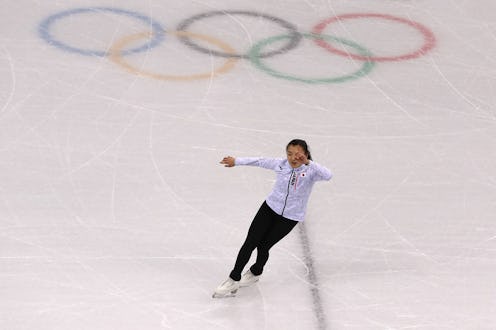News
Here's How Figure Skating Judges ACTUALLY Come Up With Those Scores

Once again, figure skating is set to take center stage — well, center rink, I should say – at the Olympic Winter Games in PyeongChang, South Korea. One of the most popular sports in the Winter Olympics, the beautiful and challenging routines astound, and to the casual observer, can sometimes appear flawless. Save a fall or obvious misstep, and all the figure skating performances can look perfect. There are some clear ways that skaters get marked down in figure skating, however, — and it's all laid out in the rules of a deeply complicated scoring system.
At the Olympics specifically, the figure skaters are judged according to the rules of the International Skating Union. There have been a ton of updates to these scoring rules (or the International Judging System, as it's called) since the 2002 Olympic Games, in an effort to combat vote trading. That was the year a Canadian pairs team were denied a gold medal in favor of the Russian team. (Ultimately, both teams were awarded the gold.)
With the current rules, skaters can gain more or fewer points in many different ways; the scoring is very complicated. But there's also a clear list of mistakes that result in clear deductions, or the skater being marked down.
As the rules put it, "deductions are applied for certain violations specified in the Regulations."
Some of the mistakes or "violations" that can result in a deduction are: Being under or over the allotted time for the program; part of one's costume falling onto the ice; actually falling; or an interruption in the performance of the program.
These deductions range from -1.0 points per violation to up to -5.0 points per program (meaning you can't receive the deduction more than once).
To understand how the scoring works, feel free to take notes. Seriously, it's complicated. There are two main types of scores: The technical element score, and the program component score.
The technical element score is to do with the difficulty of the jumps and moves, and how well they were carried out. Each move is rated between -3.0 and +3.0 grade of execution. Then, based on how hard the move was to start with, it is weighted.
For example, a triple axel gets a full 3.0 points for a +3.0 grade of execution score whereas other triple jumps get just 2.1 points because they're not considered as hard. If a negative score is given for a move, the skater gets negative points — although that's not technically a deduction.
The program component score then has more to do with the overall impression of the performance, rather than the specific nitty-gritty. There are five areas that are rated: skating skills, transitions, performance, composition and interpretation. They get a score between 0.25 to 10.0 (with 10.0 being the best).
These two types of scores are then combined into a total segment score, to decide a winner. But first, some steps are taken to remove any possible bias.
There are nine judges giving both types of scores. Two of the scores are removed randomly by a computer, leaving seven. Then the highest and lowest scores are also removed. Then the remaining five scores are used to decide the winner.
This can result in unexpected wins. Japan's Yuzuru Hanyu won the gold medal in Sochi at the last Winter Games even though he fell twice and was uneasy a few other times. But he had a strong point base to work from because of the hard jumps that he tried. In just the short program he got 101.7 points — a record. No other skater had made it above 100. That's possible when individual moves are deemed so hard to earn him 10.5 points.
The deduction for a fall is just -1.0 for the first and second, -2.0 for the third and fourth, and -3.0 for any following. That makes the rest of the scoring much more influential in deciding the winner than any mark-down.